-
Posts
679 -
Joined
-
Last visited
-
Days Won
2
Content Type
Profiles
Forums
Blogs
Gallery
Events
Store
Posts posted by Lukasz Gaszewski
-
-
[...] and a Civil OBE/CBE [...]
Certainly a CBE, as it comes between his CB and DSO (unless the first one is KCB... or higher
 ). This may help narrow the circle of suspects.0
). This may help narrow the circle of suspects.0 -
Thanks JP. I also thought about NG/SG, but what made me doubt was the lack of the appropriate inscription on the medal. My first thought, however, when I saw the medal was it must have been a NY state medal.
0 -
Thanks Hugh for this valuable information. I wonder if the medal preceded the medal of 1938 (it indeed looks like pre-WWII made) or it is still something else. One thing is obvious - it is engraved on reverse (I blurred the engraving on the photo) and was certainly worn by someone - it has traces of wearing and the ribbon is half-torn in the upper part. A real mystery to me.
0 -
Does anybody have any information about this beautiful medal?
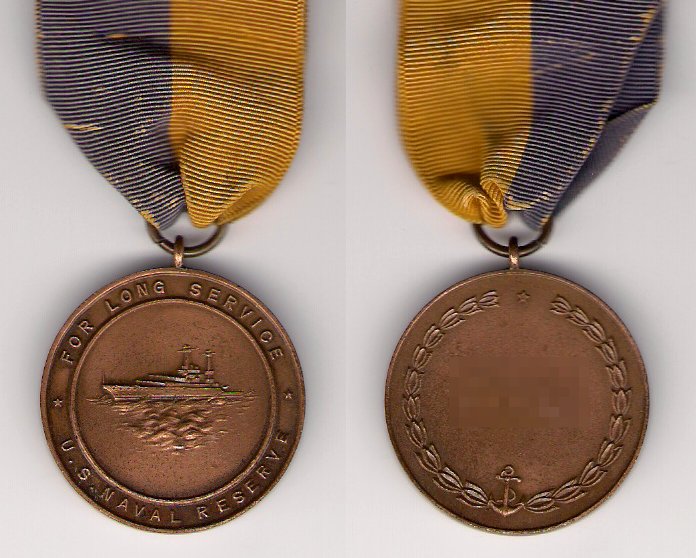 0
0 -
Yes, it is a modern replica. Nice item anyway!
0 -
Göteborgs Stads förtjänstmedalj from medalj.nu:
http://medalj.nu/ribbon_info.asp?build=&showgroups=A-Z/0/se&visitor={BAFED6C4-A9A0-4752-B025-783BD68EB21D}&listmode=0&login=&medal={F732E421-2C7A-4927-B981-92559DD8547F}

 0
0 -
Hi,
I was away on a business trip with no connection to the Net. Now that I am back I will try to answer your questions.
The decoration was established as early as in 1946 in three lower classes, the two upper ones being added in 1980. All insignia, regardless the class should be in silver. Jef's class is an Officer or Member. The cross should have a silver finish, but in may have worn away with time. It looks like an early, pre-1980 production. The ribbon is similar to that of the Polish Independence Cross - black with red side stripes, but the stripes are narrower than in the Independence Cross - only 2 mm in the two lowest classes. Following the French manner, there is a rosette in the class of Officer.
The cross had nothing to do with the communist regime in Poland - all the time it was an award of an emmigrational combatant organization of Polish soldiers in France.
I have no information about the manufacturer, but considering there are a few different types, the crosses must have been ordered at different producers.
I will consider buying it. Linasl, can you PM me your conditions?
Best,
Lukasz
0 -
Thanks for the consent - I will add the star soon.
I am afraid it is not possible to determine the class
 The stars of both highest classes are identical.
The stars of both highest classes are identical.Lukasz
0 -
Hi,
The star is a genuine one. It is a star of the Decoration of Merit of the Association of Members of Polish Resistance in France (ZUPRO), whose president and also the "Grand Master" of the decoration was Colonel (later General) Antoni Zdrojewski (1900-89), who organized the Polish Organization for Fighting for Independence (POWN).
The decoration, initially in three classes, was eventually extended to five, to reflect the structure of a typical order of merit. I cannot tell you the exact year of institution, but the two upper classes appeared in ca. 1980s. The star was attached to the class of Grand Cross and Grand Commnder. The decoration, initially meant to honor merit to the Association, was later honorarily awarded to members of democratic opposition in Poland as well.
I cannot tell you the exact price of the star. Lower class crosses are ocassionally seen at auctions, with starting price of ca. 200-300 euros.
Can you upload a photo of the hallmark? It may help identify the manufacturer.
Hope this will help.
One more thing: can I add the photo of the star to my website about Polish Orders and Medals (www.medals.pl/pl), all credits given of course?
0 -
Thanks a lot Jeff
 :jumping:
:jumping:  . I felt they could be ROTC related. If you happen to find any more detailed information regarding them, please let me know.
. I felt they could be ROTC related. If you happen to find any more detailed information regarding them, please let me know.Lukasz
0 -
Recently I came across these two ribbon bars. They are completely unknown to me, except that they are almost certainly US items and they do not look new, though in a good condition. Does anyone have any idea what they are?
Lukasz
 0
0 -
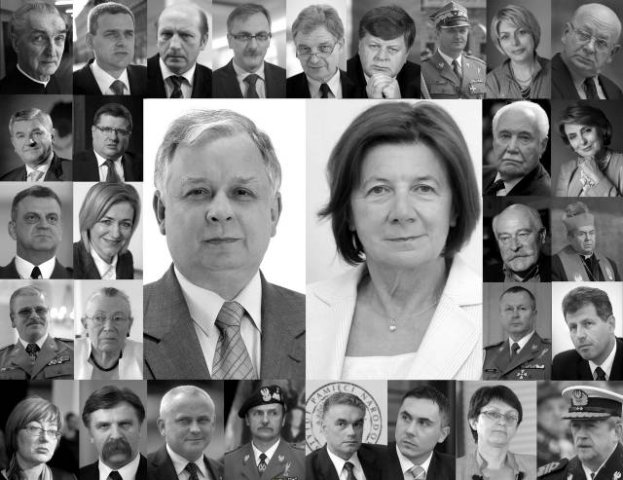
(Photo courtesy 'Gazeta Wyborcza')
On April 10, 2010 ninety six Polish citizens lost their lives in a plane crash in Smolensk, Russia, on their way to the Katyn cementery, to celebrate the 70th anniversary of the murder by the NKVD of more than 20 thousand Polish officers, taken prisoner during the 1939 Soviet invasion of Poland. The group included President of Poland, Lech Kaczynski and his wife Maria, the last President in Exile, Ryszard Kaczorowski, Deputy Presidents of the House of Representatives, Krzysztof Putra and Jerzy Szmajdzinski, Deputy President of the Senate, Ms. Krystyna Bochenek, President of the Bank of Poland, Slawomir Skrzypek, the catholic, orthodox and lutheran bishops of the Armed Forces od Poland, Chief of Staff, Gen. Franciszek Gagor, and other generals, Chancellor of the Order Virtuti Militari, Gen. Stanislaw Nalecz-Komornicki, members of the House of Representatives and the Senate, members of Presidential Chancellery, state officials, members of families of officers murdered in Katyn, security officers and plane crew. Among the victims of the crash, there was also Ms. Anna Walentynowicz, the legendary leader of Polish democratic opposition, whose being fired in 1980 gave the impulse to begin the strike in the Gdansk shipyard, which eventually resulted in the creation of the Solidarnosc movement.
The number of victims, most of whom were top national politicians and officials makes this disaster an unprecedented one in the history of world aviation. The place where it happened makes their death even more symbolic.
The funeral ceremony of the President and his wife will take place on Sunday, April 18, at the Wawel Cathedral in Cracow, the resting place of Polish monarchs and national heroes including General Kosciuszko, Marshal Pilsudski and General Sikorski.
I am sorry publishing this tragic news here, but I simply felt I had to share it with you. I could not find a better place on this forum to publish it.
Lukasz Gaszewski
0 -
Thanks Megan, I think I once saw some small spiral devices attached to service ribbons for multiple awards. I searched for them everywhere I could, on the Net, on my hard disc and in the books on Greek awards I have - nowhere! Was it only me or were they real?
0 -
Hello,
Just wonder if someone could post any photos of the devices that were used with Greek ribbon bars to denote multiple awards. Thanks in advance.
Lukasz
0 -
Nice indeed! Any information about the recipient?
0 -
The second ribbon in the first bar is the ribbon of the French Croix du Combattant.
0 -
I am suspicious about this group. What makes a red light turn on in my brain is the Dienstauszeichnung for 4 years of service in the Luftwaffe. I wonder what military career of that chap could be. He was definitely an officer of the K.u.K. Army during WWI, probably at least a captain by the end of war (MVK was seldom awarded to ranks below captain). He must have been already an officer before 1916 (Signum Laudis w. Franz-Joseph's effigy).
Where was he from and what was he doing after WWI? The Dienstauszeichnung for service in the Wehrmacht was established in 1936. Its conferment was discontinued I believe in early 1940. This means that - no matter where he may have lived before - the gentleman must have moved to the Reich and commenced his sevice in the Luftwaffe, not later than in 1936 - earlier than the German occupation of Czechoslovakia or the Anschluss of Austria.
To make things even more complicated, there is a KVK 2nd class w. Swords - what could he get it for?
To sum it up: I believe it to be just a compilation of various awards, not a group that belonged to someone particular.
0 -
Are you sure the ribbon bar lying on the photo is the same the man is wearing? I personally do not think the uniform is Polish at all and certainly not from 1920-22 era. Open collars and ties began to be used in the Polish Armed Forces in 1936 (in the air force), in the army as late as in 1939/40 in the Polish Army in France. If it was a WWII Polish army uniform, it would most probably have collar patches on it. To me it looks more Yugoslavian or Czech, unfortunately it is a typical military jacket, you cannot see the rank and the photo is too blurred to see details. I think it will be difficult to figure out without knowing further details about the photo itself :(
0 -
I believe the Soviet-like uniforms and insignia were adopted in Cuba in 1970s (according to my information by "Ley No. 1315 sobre el sistema de grados militares de las FAR, de la República de Cuba" of November 23, 1976) but they might be in use some time before. I remember in 1981, being in what was then called Leningrad and now is back St. Petersburg I was on the tram with I thought a Soviet Army captain. Only upon a closer examination I found to my surprise that the insignia on his peaked cap were not Soviet. He explained that he was Cuban. Except the coat of arms on the cap, his uniform was identical to what Soviet officers wore at that time!
Below is the chart of what FAR ranks looked like before the Soviet pattern was adopted.
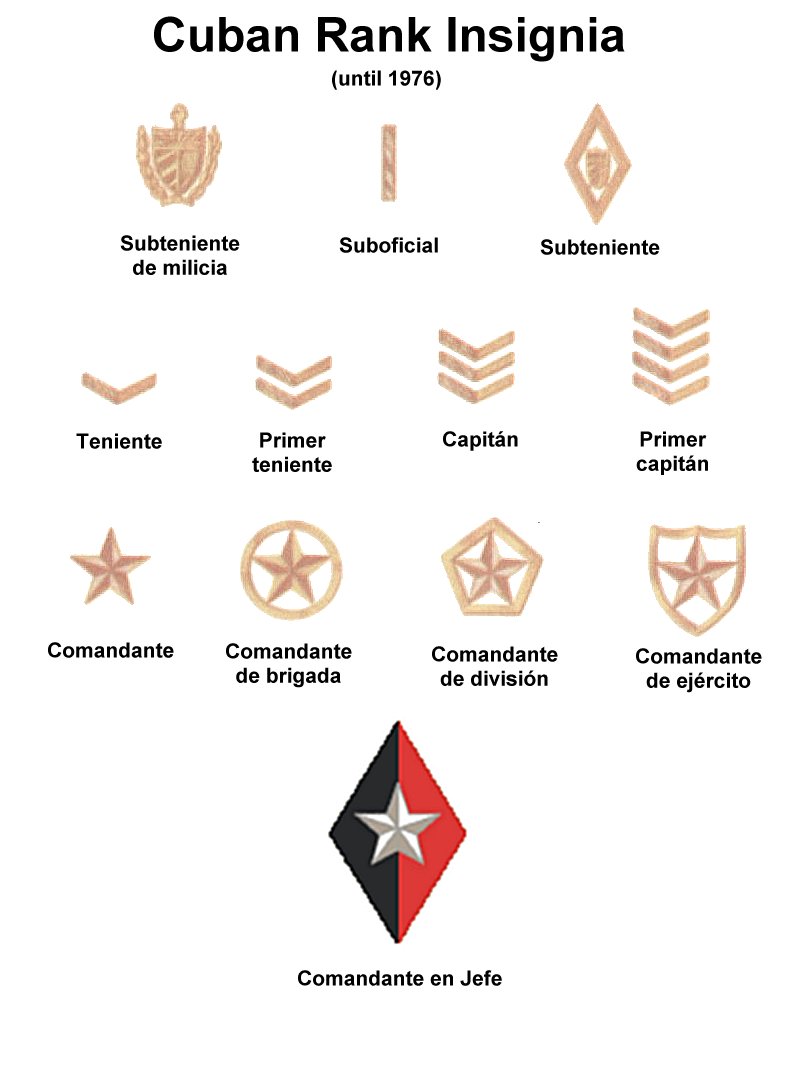
Btw: I am interested in the rank of "Comandante de la revolución". Who held/holds it? I know that the rank of Comandante en Jefe is reserved to Fidel, while Raul is a General de Ejército (I think the only one).
Slightly off-topic: does anybody know what the ranks of pre-Castro era looked like?
0 -
Just wonder if somebody can identify the Pakistani medals represented by these two ribbon bars. The photos I have suggest they must both have been established before 2008.


Below are the photos of Gen. Musharraf, Gen. Kayani and another general, all wearing both ribbons. Note the position. On Musharraf's uniform, the first ribbon is placed between the 30 and 40 years of service medals, which can be some hint (a medal for 35 years of service ???). The other ribbon is the last Pakistani one, which would suggest either a new commemorative/jubilee medal or a fairly low decoration (shooting medal ?). Note a device which looks like MID badge on Musharraf's and Kayani's ribbons.
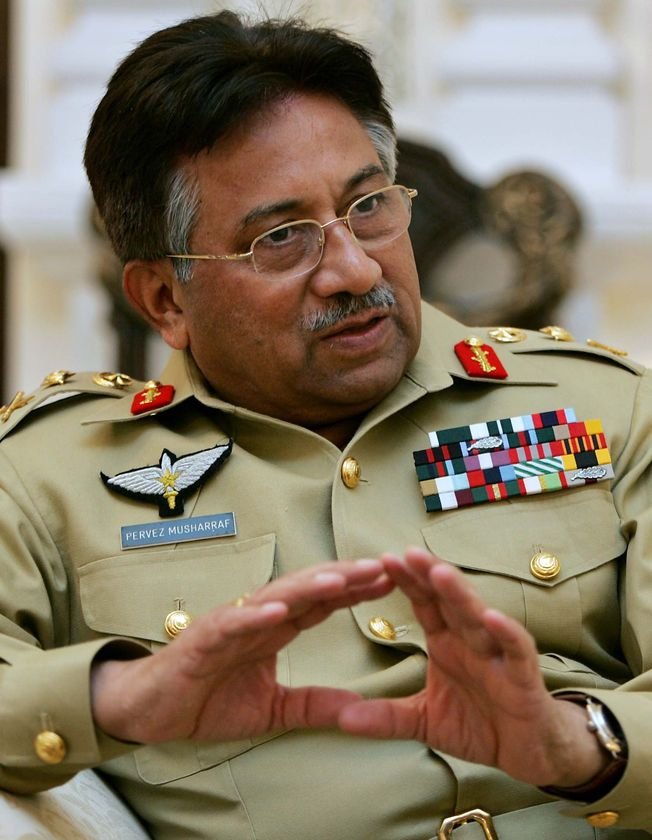
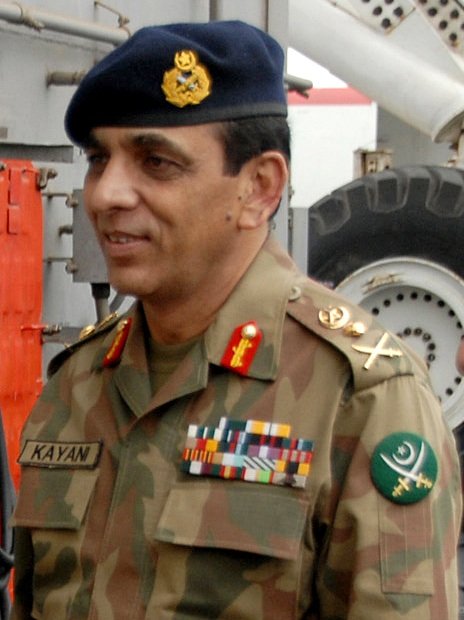
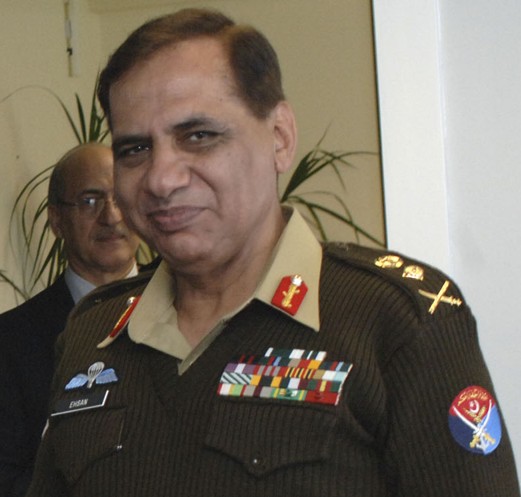 0
0 -
Rick and Daniel. You are absolutely correct! This gentleman is General Wojciech Jaruzelski. He was the Minister of National Defense, 1st Secretary of the United Polish Workers Party (PZPR), Prime Minister and finally the first (and last) President of People's Poland. He is best known of indroducing the martial law in Poland on December 13, 1981.
As nobody has recognized any of his ribbons (I do not have any better photo at the moment, sorry), here is another hint. The ribbons are of the following countries (not necessarily in this order): Poland, Bulgaria, Czechoslovakia, East Germany, Hungary, Mongolia, North Korea, Romania and USSR. The ribbons are the same set (and probably the same uniform) that he was wearing when announcing the martial law on TV.
Happy hunting!
Lukasz
0 -
I initially wanted to post this in Christophe's quiz thread, but decided to open up a new topic instead.
Two questions:
1. Who is this gentleman in a uniform and dark glasses? (the easier question)
2. The ribbon bars of what decorations is he wearing? (the more difficult one)
A hint: all his awards are Soviet bloc awards.
Happy guessing!
Lukasz

Enlarged photo:
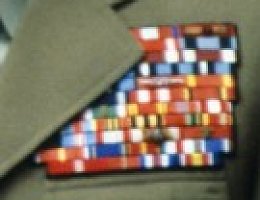 0
0 -
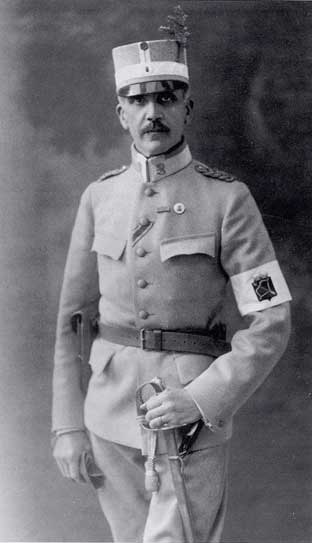
The second officer is a Major General. Finnish officers used to wear collar laces, strikingly similar to Austro-Hungarian ones. The rank is denoted by a single lion on the collar. The ribbon in the buttonhole is of the Prussian Iron Cross.
0 -
Not sure if I have ever seen an actual one. Still, here is a photo from Greg Ogletree's book. It may have been replaced by a "ribbon-only" award. The ribbon should be yellow with blue stripes.
Lukasz
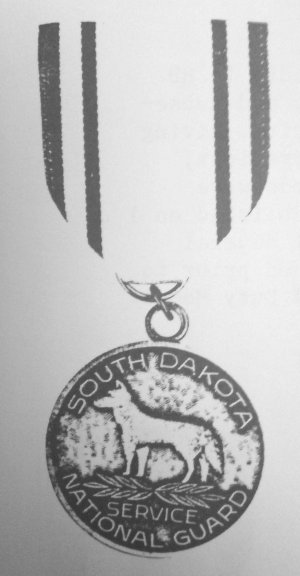 0
0




identifcation uniform bars
in Northern European & Baltic States
Posted
I think #12 is the Decoration of Honor of the Italian General Staff. I cannot figure out #11. It looks very strange to me.